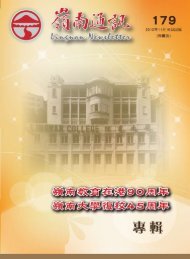the chinese at work: collectivism or individualism? - Lingnan ...
the chinese at work: collectivism or individualism? - Lingnan ...
the chinese at work: collectivism or individualism? - Lingnan ...
Create successful ePaper yourself
Turn your PDF publications into a flip-book with our unique Google optimized e-Paper software.
HKIBS/WPS/040-001February 2001THE CHINESE AT WORK:COLLECTIVISM OR INDIVIDUALISM?Edward Yui-tim. WONGAssistant Profess<strong>or</strong>Department of Management<strong>Lingnan</strong> UniversityTuen Mun, Hong KongTelephone: (852) 2616 8315Fax: (852) 24670982E-mail: wongyt@ln.edu.hkEdward Y. T. Wong is an assistant profess<strong>or</strong> of management <strong>at</strong> <strong>Lingnan</strong> University. Hereceived his Ph.D. from <strong>the</strong> Chinese University of Hong Kong and MSc from <strong>the</strong> LondonSchool of Economics and Political Science. His research interests concern <strong>or</strong>ganiz<strong>at</strong>ionalcommitment and trust of employees, employees’ <strong>w<strong>or</strong>k</strong> <strong>at</strong>titude and perf<strong>or</strong>mance in China.Hong Kong Institute of Business Studies<strong>Lingnan</strong> UniversityTuen MunHong KongTel: (852) 2616 8373Fax: (852) 2572 4171
THE CHINESE AT WORK:COLLECTIVISM OR INDIVIDUALISM?ABSTRACTOne of <strong>the</strong> significant fe<strong>at</strong>ures of <strong>the</strong> n<strong>at</strong>ional culture of <strong>the</strong> Chinese in China and o<strong>the</strong>rChinese-maj<strong>or</strong>ity societies is “<strong>collectivism</strong>” <strong>or</strong> “low <strong>individualism</strong>” (Hofstede, 1984; Hofstede andBond, 1988; Hofstede, 1993). Does it imply th<strong>at</strong> <strong>the</strong> Chinese <strong>at</strong> <strong>w<strong>or</strong>k</strong> are collective subjects, with“group <strong>or</strong>ient<strong>at</strong>ion”? Different people may have different views on this question. This paperchallenges such popular assumptions about Chinese <strong>w<strong>or</strong>k</strong> behavi<strong>or</strong> of “<strong>collectivism</strong>”. Drawing onstudies from P.R.C., Hong Kong, Taiwan and Singap<strong>or</strong>e, it questions whe<strong>the</strong>r <strong>the</strong> logic of ChineseConfucian <strong>collectivism</strong>, prevailing in traditional Chinese family, still applies in today’s <strong>w<strong>or</strong>k</strong><strong>or</strong>ganiz<strong>at</strong>ion. Based on <strong>the</strong> studies of <strong>collectivism</strong> and <strong>individualism</strong> in Chinese-maj<strong>or</strong>ity societies, <strong>the</strong>controversial issue of <strong>collectivism</strong> is discussed, and implic<strong>at</strong>ions f<strong>or</strong> future studies of <strong>collectivism</strong> and<strong>individualism</strong> are also derived.
INTRODUCTIONSince 1978, economic ref<strong>or</strong>ms in China allow <strong>the</strong> establishment of special economic zones(SEZs) and a series of policy to <strong>at</strong>tract f<strong>or</strong>eign direct investment. Since <strong>the</strong>n, <strong>the</strong> PRC is viewed asan intern<strong>at</strong>ional management site f<strong>or</strong> studying. One of <strong>the</strong> advantage is th<strong>at</strong> <strong>the</strong>re are a number of“predominantly Chinese” societies (such as PRC, Hong Kong, Taiwan, and Singap<strong>or</strong>e,) as wellChinese communities all over <strong>the</strong> w<strong>or</strong>ld, researchers studying management in <strong>the</strong> PRC can makecomparisons of political and economic variables in which <strong>the</strong> impact of culture is controlled (Shenkar,1994). It means th<strong>at</strong> China presents us with research opp<strong>or</strong>tunities f<strong>or</strong> examining <strong>the</strong> universality of<strong>the</strong> Western-developed <strong>the</strong><strong>or</strong>ies and research instruments.One way of examining <strong>or</strong>ganiz<strong>at</strong>ional behavi<strong>or</strong> across cultures and explaining <strong>the</strong> differencesth<strong>at</strong> exist is to look <strong>at</strong> imp<strong>or</strong>tant dimensions of culture. One of <strong>the</strong> significant fe<strong>at</strong>ures of <strong>the</strong> n<strong>at</strong>ionalculture of <strong>the</strong> Chinese in China and o<strong>the</strong>r Chinese-maj<strong>or</strong>ity societies is “<strong>collectivism</strong>” <strong>or</strong> “low<strong>individualism</strong>” (Hofstede, 1984; Hofstede and Bond, 1988; Hofstede, 1993). Does it imply th<strong>at</strong> <strong>the</strong>Chinese <strong>at</strong> <strong>w<strong>or</strong>k</strong> are collective subjects, with “group <strong>or</strong>ient<strong>at</strong>ion”? Different people may havedifferent views to this question. This paper challenges such popular assumptions about Chinese<strong>w<strong>or</strong>k</strong> behavi<strong>or</strong> of “<strong>collectivism</strong>”. Draw on studies from P.R.C., Hong Kong, Taiwan and Singap<strong>or</strong>e,it questions whe<strong>the</strong>r <strong>the</strong> logic of Chinese Confucian <strong>collectivism</strong>, prevailing in traditional Chinesefamily, still applies in today’s <strong>w<strong>or</strong>k</strong> <strong>or</strong>ganiz<strong>at</strong>ion. The aim of <strong>the</strong> paper is to investig<strong>at</strong>e why <strong>the</strong>re aresuch inconsistent research findings and contradict<strong>or</strong>y views and wh<strong>at</strong> are its implic<strong>at</strong>ions. Hence, acluster of relevant questions will be examined in this paper, including <strong>the</strong> followings:(1) Are Chinese societies “collectivist” <strong>or</strong> “individualist”?(2) Suppose <strong>the</strong>re is “<strong>collectivism</strong>” among Chinese, <strong>the</strong>n wh<strong>at</strong> are <strong>the</strong> causes, f<strong>or</strong>ms andcharacteristics of such “<strong>collectivism</strong>”? Are <strong>the</strong>re any differences between <strong>the</strong> “<strong>collectivism</strong>”among Chinese and th<strong>at</strong> in o<strong>the</strong>r countries?(3) Wh<strong>at</strong> are <strong>the</strong> significance and implic<strong>at</strong>ions of <strong>the</strong> “<strong>collectivism</strong>” and “<strong>individualism</strong>” amongChinese to <strong>the</strong> study of group culture of <strong>or</strong>ganiz<strong>at</strong>ion in China and in o<strong>the</strong>r countries?1
(4) How might we establish gre<strong>at</strong>er conceptual clarity by distinguishing different types of<strong>collectivism</strong>, which may different from one ano<strong>the</strong>r and from <strong>individualism</strong>?INDIVIDUALISM AND COLLECTIVISMHofstede (1991, P.5) defined “culture” as <strong>the</strong> collective programming of <strong>the</strong> mind whichdistinguishes <strong>the</strong> members of one group <strong>or</strong> c<strong>at</strong>eg<strong>or</strong>y of people from those of ano<strong>the</strong>r. In a hugestudy involving 116,000 respondents, Hofstede (1980) found highly significant differences in <strong>the</strong>behavi<strong>or</strong> and <strong>at</strong>titudes of IBM employees from seventy countries. Since all his d<strong>at</strong>a were collectedfrom one company, <strong>the</strong> study has been criticized f<strong>or</strong> not being represent<strong>at</strong>ive of <strong>the</strong> differentcountries. Since <strong>the</strong> cultural influences on management are clearly recognizable <strong>at</strong> <strong>the</strong> n<strong>at</strong>ional level,Hofstede had identified four dimensions of n<strong>at</strong>ional culture (Hofstede, 1980): power distance,uncertainty avoidance, <strong>individualism</strong> and masculinity.The dimension of <strong>collectivism</strong>-<strong>individualism</strong> is one of <strong>the</strong> maj<strong>or</strong> cultural variabilities discussedby <strong>the</strong><strong>or</strong>ists across disciplines (e.g. Hofstede, 1980; Hui and Triandis, 1986; Triandis, 1986). It hasbeen widely used in behavi<strong>or</strong>al studies in different contexts and in different countries (e.g., Dyne etal., 2000; Gelfand and Realo, 1999; Ramamo<strong>or</strong>thy and Carroll, 1998). Acc<strong>or</strong>ding to Hofstede(1994), “<strong>individualism</strong>” is <strong>the</strong> degree to which people in a country prefer to act as individuals ra<strong>the</strong>r<strong>the</strong>n as members of groups. The opposite of <strong>individualism</strong> is “<strong>collectivism</strong>”. In collectivist societies,a child learns to respect <strong>the</strong> group to which it belongs, usually <strong>the</strong> family, and to differenti<strong>at</strong>e betweenin-group members and out-group members (th<strong>at</strong> is, all o<strong>the</strong>r people). When children grow up <strong>the</strong>yremain members of <strong>the</strong>ir group, and <strong>the</strong>y expect <strong>the</strong> group to protect <strong>the</strong>m when <strong>the</strong>y are in trouble.In return, <strong>the</strong>y have to remain loyal to <strong>the</strong>ir group throughout life. In individualist societies, a childlearns very early to think of itself as “I” instead of as part of “we”. It expects one day to have tostand on its own feet and not get protection from its group anym<strong>or</strong>e; and <strong>the</strong>ref<strong>or</strong>e it also does notfeel a need f<strong>or</strong> strong loyalty (Hofstede, 1994).F<strong>or</strong> many years, <strong>the</strong> Chinese-maj<strong>or</strong>ity society like PRC, Hong Kong, Taiwan and Singap<strong>or</strong>ewere classified by Hofstede as “low <strong>individualism</strong>” <strong>or</strong> “<strong>collectivism</strong>” (see Table 1 and Table 2), andhad a rel<strong>at</strong>ively high degree of <strong>collectivism</strong>. However, inconsistent research findings and2
contradict<strong>or</strong>y views regarding <strong>the</strong> “<strong>collectivism</strong>” and “<strong>individualism</strong>” of <strong>the</strong> Chinese <strong>at</strong> <strong>w<strong>or</strong>k</strong> havebeen found. These will be discussed below.----------------------------Insert Table 1 about here--------------------------------------------------------Insert Table 2 about here----------------------------STUDIES OF COLLECTIVISM AND INDIVIDUALISMIN CHINESE-MAJORITY SOCIETIESMany research findings confirm th<strong>at</strong> <strong>the</strong> Chinese are collective subjects, with <strong>the</strong> characteristicsof “group <strong>or</strong>ient<strong>at</strong>ion”. F<strong>or</strong> instance, Chinese-maj<strong>or</strong>ity society has been found with <strong>the</strong>characteristics of <strong>collectivism</strong> (Hofstede, 1984). Leung and Bond (1984) also found th<strong>at</strong> <strong>the</strong>concern of collective Chinese subjects was m<strong>or</strong>e <strong>or</strong>iented toward enhancing in-group harmony.Besides, group <strong>or</strong>ient<strong>at</strong>ion is considered as a key fe<strong>at</strong>ure of Chinese culture, and is common to <strong>the</strong>PRC, Hong Kong, Taiwan and overseas Chinese (Lockett, 1988). One of <strong>the</strong> implic<strong>at</strong>ions of <strong>the</strong>group <strong>or</strong>ient<strong>at</strong>ion of Chinese is th<strong>at</strong> <strong>the</strong> cultural assumptions of Western management <strong>the</strong><strong>or</strong>iesbecome less applicable to Chinese <strong>or</strong>ganiz<strong>at</strong>ions. F<strong>or</strong> instance, Redding (1980) rep<strong>or</strong>ted researchfindings from Hong Kong managers of higher sc<strong>or</strong>es f<strong>or</strong> “social needs”. Nevis (1983) alsoproposed f<strong>or</strong> a “Chinese hierarchy of needs” in which “self-actualiz<strong>at</strong>ion in <strong>the</strong> service of society”replaced Maslow’s individually-defined need f<strong>or</strong> “self-actualiz<strong>at</strong>ion.” In addition, basing on <strong>the</strong>sc<strong>or</strong>es of low <strong>individualism</strong> of Hong Kong, Taiwan and Singap<strong>or</strong>e, China is also estim<strong>at</strong>ed to becountry of low <strong>individualism</strong> (see Table 1 and 2). Hence, most of <strong>the</strong> studies of <strong>individualism</strong><strong>collectivism</strong>have classified <strong>the</strong> Chinese-maj<strong>or</strong>ity societies as collectivist societies, and <strong>the</strong> Chinese <strong>at</strong><strong>w<strong>or</strong>k</strong> are assumed to be collective subjects with <strong>the</strong> characteristics of high <strong>collectivism</strong> (Earley, 1989;Earley, 1994).3
Table 3 shows <strong>the</strong> maj<strong>or</strong> studies of <strong>collectivism</strong> and <strong>individualism</strong> in Chinese-maj<strong>or</strong>itysocieties. Inconsistent and contradict<strong>or</strong>y research findings of <strong>individualism</strong>-<strong>collectivism</strong> have beenfound in China, Hong Kong, Taiwan and Singap<strong>or</strong>e. F<strong>or</strong> instance, empirical evidence of <strong>the</strong> HongKong Chinese altruistic and individualistic <strong>at</strong>titude toward <strong>the</strong>ir <strong>w<strong>or</strong>k</strong>, occup<strong>at</strong>ion and <strong>or</strong>ganiz<strong>at</strong>ion(Ng, 1975; Ng, 1983) has been found. Besides, <strong>the</strong> individual conflict of Hong Kong Chinese isobserved to be m<strong>or</strong>e significant and notable than collective conflict (Wong, 1990). In addition, <strong>the</strong>managerial values of young managers in PRC are also changing. F<strong>or</strong> instance, Birnbaum-M<strong>or</strong>e,Wong and Olve (1995) found th<strong>at</strong> <strong>the</strong> acquisition of <strong>individualism</strong> of younger managerial trainees washigher in <strong>the</strong> PRC than in Hong Kong. And a growing spirit of “Chinese-style” <strong>individualism</strong> is notedand m<strong>or</strong>e Western ways of thinking are being adopted by young Chinese managers in PRC (Ralston,Gustafson, Terpstra and Holt, 1995).----------------------------Insert Table 3 about here----------------------------Even though both <strong>the</strong> Chinese and Japanese have been classified as collective subjects (seeTable 2), differences in fact<strong>or</strong>s th<strong>at</strong> make up <strong>the</strong> <strong>individualism</strong> value dimensions of Singap<strong>or</strong>eanChinese and Japanese managers have been found, and <strong>the</strong> differences in <strong>w<strong>or</strong>k</strong> values between <strong>the</strong>mhave be explained by both cultural and n<strong>at</strong>ional fact<strong>or</strong>s (Chew and Puttic, 1995). Ano<strong>the</strong>r study alsoshows th<strong>at</strong> although <strong>the</strong> Chinese in Taiwan are in favour of <strong>collectivism</strong>, <strong>the</strong>y do not carry <strong>the</strong>irloyalty to <strong>the</strong>ir <strong>w<strong>or</strong>k</strong>place (Yeh, 1988a and 1988b). This implies th<strong>at</strong> <strong>the</strong>re are differences between<strong>the</strong> “<strong>collectivism</strong>” among Chinese and th<strong>at</strong> in o<strong>the</strong>r countries.4
THE CHINESE AT WORK: COLLECTIVISM OR INDIVIDUALISM?The inconsistent findings of both <strong>collectivism</strong> and <strong>individualism</strong> in Chinese-maj<strong>or</strong>ity societiesshow th<strong>at</strong> <strong>the</strong> popular assumptions about Chinese <strong>w<strong>or</strong>k</strong> behavi<strong>or</strong> of “<strong>collectivism</strong>” is controversial.But most of <strong>the</strong> previous studies just accept such assumptions without questioning. The discussionbelow <strong>at</strong>tempts to investig<strong>at</strong>e <strong>the</strong> underlying reasons f<strong>or</strong> <strong>the</strong> inconsistent findings of <strong>collectivism</strong>.Some implic<strong>at</strong>ions f<strong>or</strong> fur<strong>the</strong>r researches are also derived.The Traditional Chinese Culture and Collectivism of ChineseThe Chinese have a cultural hist<strong>or</strong>y which d<strong>at</strong>es back f<strong>or</strong> m<strong>or</strong>e than four thousand years. Thecultural values still have certain impacts to <strong>the</strong> behavi<strong>or</strong> of today’s Chinese. F<strong>or</strong> instance, Lockett(1988) suggests th<strong>at</strong> four key elements can be identified to be common in <strong>the</strong> PRC, Taiwan, HongKong and probably among overseas Chinese. The four elements are respect f<strong>or</strong> age and hierarchicalposition, group <strong>or</strong>ient<strong>at</strong>ion, concept of face and imp<strong>or</strong>tance of rel<strong>at</strong>ionships. Tan (1990) had alsoidentified some significant values in Chinese culture, including <strong>the</strong> imp<strong>or</strong>tance of <strong>the</strong> family <strong>or</strong> kinshipgroups, respects f<strong>or</strong> elders, oblig<strong>at</strong>ions toward friends and rel<strong>at</strong>ives, <strong>the</strong> avoidance of conflict, <strong>the</strong>need f<strong>or</strong> harmony and <strong>the</strong> concept of face. Some of <strong>the</strong>se values can be used to explain <strong>the</strong>“<strong>collectivism</strong>” of traditional Chinese. F<strong>or</strong> instance, in a Chinese society, rel<strong>at</strong>ionships begin with <strong>the</strong>immedi<strong>at</strong>e family as an in-group and are <strong>the</strong>n radi<strong>at</strong>ed to <strong>the</strong> extended family and village. In such acollectivist society, an hon<strong>or</strong> bestowed upon a family member is shared by <strong>the</strong> family and beyond.Due to <strong>the</strong> oblig<strong>at</strong>ions towards rel<strong>at</strong>ives, it is common f<strong>or</strong> rel<strong>at</strong>ives brought in to help in variouspositions in a family owned business. It can be seen th<strong>at</strong> most early studies of <strong>individualism</strong><strong>collectivism</strong>of Chinese basing on <strong>the</strong> cultural explan<strong>at</strong>ion tend to agree <strong>or</strong> conclude th<strong>at</strong> <strong>the</strong> Chineseare collective subjects with <strong>the</strong> group <strong>or</strong>ient<strong>at</strong>ion (Hofstede, 1984; Leung and Bond, 1984; Shenkarand Ronen, 1987; Lockett, 1988). However, <strong>the</strong> findings of Ralston, Gustafson, Cheung andTerpstra (1993) indic<strong>at</strong>e th<strong>at</strong> often times both culture and <strong>the</strong> business environment interact to cre<strong>at</strong>ea unique set of managerial values in a country. It suggests th<strong>at</strong> f<strong>or</strong> studying <strong>the</strong> Chinese behavi<strong>or</strong> in<strong>w<strong>or</strong>k</strong>place, <strong>the</strong> fact<strong>or</strong> of business environment should not be neglected.5
The “Passive F<strong>at</strong>alism” of <strong>the</strong> ChineseNg (1990) suggested <strong>the</strong> concept of “passive f<strong>at</strong>alism” as an explan<strong>at</strong>ion of <strong>the</strong> apparentcollectivist <strong>or</strong>ient<strong>at</strong>ion of <strong>the</strong> Chinese. Basing on <strong>the</strong> evidence from P.R.C., Hong Kong, and Taiwan,Ng suggested a psychological adaptability of <strong>the</strong> Chinese toward ref<strong>or</strong>ms initi<strong>at</strong>ed and directed fromabove <strong>at</strong> <strong>w<strong>or</strong>k</strong>. He argued th<strong>at</strong> <strong>the</strong> quiescent readiness of <strong>the</strong> <strong>w<strong>or</strong>k</strong>ers to reconcile <strong>the</strong>mselves withauth<strong>or</strong>ity does not represent a group spirit of team<strong>w<strong>or</strong>k</strong>. Ra<strong>the</strong>r, he suggested th<strong>at</strong> <strong>the</strong> psychologyof “passive f<strong>at</strong>alism” is rooted in <strong>the</strong> religious values of Buddhism and Taoism. Ng (1990) alsoargued th<strong>at</strong> <strong>the</strong> <strong>w<strong>or</strong>k</strong> altruism of <strong>the</strong> Chinese does not imply an unquestioned and total readiness tosacrifice f<strong>or</strong> <strong>the</strong> collective good of <strong>the</strong> enterprise <strong>or</strong> a cultural preference f<strong>or</strong> team and group, as in<strong>the</strong> case of Japanese <strong>w<strong>or</strong>k</strong>ers. The concept of “passive f<strong>at</strong>alism” can help explain <strong>the</strong> co-existenceof collectivist <strong>or</strong>ient<strong>at</strong>ion and individualistic <strong>or</strong>ient<strong>at</strong>ion of <strong>the</strong> Chinese in <strong>w<strong>or</strong>k</strong>place to a certain extent.However, it has not yet specified under wh<strong>at</strong> circumstances will <strong>the</strong> Chinese behave as collectivesubjects <strong>or</strong> individual subjects.Vertical Collectivism and H<strong>or</strong>izontal Collectivism of ChineseThere are four kinds of self: independent <strong>or</strong> interdependent (Markus and Kitayama, 1991)and same <strong>or</strong> different. The combin<strong>at</strong>ions of <strong>the</strong>se four types can be c<strong>at</strong>eg<strong>or</strong>ized as h<strong>or</strong>izontal<strong>individualism</strong> (independent/same) and h<strong>or</strong>izontal <strong>collectivism</strong> (interdependent/same), vertical<strong>individualism</strong> (independent/different) and vertical <strong>collectivism</strong> (interdependent/different).These h<strong>or</strong>izontal and vertical dimensions of <strong>individualism</strong> and <strong>collectivism</strong> help us have abetter understanding of <strong>the</strong> Chinese “<strong>collectivism</strong>”. F<strong>or</strong> example, Chen and Meindl (submitted)found th<strong>at</strong> Chinese who were vertical collectivists supp<strong>or</strong>ted ref<strong>or</strong>ms introduced by <strong>the</strong> Communistparty, whereas <strong>the</strong> h<strong>or</strong>izontal collectivists were opposed to <strong>the</strong>se ref<strong>or</strong>ms. It should be noted th<strong>at</strong><strong>the</strong> h<strong>or</strong>izontals have fundamentally Confucian values of cohesion and thus consider <strong>the</strong> ref<strong>or</strong>ms asweakening solidarity. In addition, h<strong>or</strong>izontal <strong>collectivism</strong> was found c<strong>or</strong>rel<strong>at</strong>ed -.13 (p< .05) withpreference f<strong>or</strong> differential rules f<strong>or</strong> composition in an <strong>or</strong>ganiz<strong>at</strong>ion. It implies th<strong>at</strong> <strong>the</strong> study of<strong>collectivism</strong> of Chinese in Chinese-maj<strong>or</strong>ity societies is needed carefully divided into vertical<strong>collectivism</strong> and h<strong>or</strong>izontal <strong>collectivism</strong>.6
It is noted th<strong>at</strong> also changing values of Chinese managers in China in recent years. F<strong>or</strong>instance, after examining <strong>the</strong>re is <strong>the</strong> apparent evolution in <strong>w<strong>or</strong>k</strong> values among young Chinesemanagers in Shanghai over a 2½ - year period, Ralston et al. (1995) suggested a growing spirit of“Chinese -style” <strong>individualism</strong> and m<strong>or</strong>e Western ways of thinking are being adopted by <strong>the</strong>se youngChinese managers in China. Birnbaum-M<strong>or</strong>e et al. (1995) also found th<strong>at</strong> younger PRC managerialtrainees who had values th<strong>at</strong> were closet to those of Hong Kong managers of all ages, and <strong>the</strong>acquisition of <strong>individualism</strong> was even higher in <strong>the</strong> PRC than in Hong Kong. Hence, it is reasonableto challenge <strong>the</strong> stereotypic notion of <strong>collectivism</strong> among <strong>the</strong> Chinese today.CONCLUSION AND IMPLICATIONSMost Western studies on Chinese culture have accepted <strong>the</strong> stereotypic notion of<strong>collectivism</strong> of <strong>the</strong> Chinese (Hofstede, 1984; Leung and Bond, 1984; Shenkar and Ronen, 1987).This paper challenges such popular assumptions about Chinese <strong>w<strong>or</strong>k</strong> behavi<strong>or</strong> of “<strong>collectivism</strong>”.Based on <strong>the</strong> studies of <strong>collectivism</strong> and <strong>individualism</strong> in Chinese-maj<strong>or</strong>ity societies, <strong>the</strong> controversialissue of <strong>collectivism</strong> is examined and discussed.As a conclusion, we have to acknowledge th<strong>at</strong> <strong>the</strong> traditional Chinese culture has its impacton <strong>the</strong> development of <strong>collectivism</strong> among Chinese. But <strong>the</strong> Chinese <strong>collectivism</strong> is mainly reflectedin loyalty towards <strong>the</strong> family whereas <strong>the</strong> Japanese can reflect a high allegiance to <strong>the</strong> <strong>w<strong>or</strong>k</strong>place.Besides, <strong>the</strong> study of Chinese <strong>collectivism</strong> should be c<strong>at</strong>eg<strong>or</strong>ized into <strong>the</strong> dimensions of vertical<strong>collectivism</strong> and h<strong>or</strong>izontal <strong>collectivism</strong> in different Chinese-maj<strong>or</strong>ity societies.With a popul<strong>at</strong>ion of about 1.2 billion inhabitants in <strong>the</strong> People’s Republic of China toge<strong>the</strong>rwith <strong>the</strong> gre<strong>at</strong> number of Chinese sc<strong>at</strong>tered in o<strong>the</strong>r Chinese-maj<strong>or</strong>ity societies, <strong>the</strong> study of<strong>collectivism</strong> and <strong>individualism</strong> of Chinese is significant and has <strong>the</strong> following implic<strong>at</strong>ions. Firstly, it istoo simplistic to accept <strong>the</strong> popular assumptions of Chinese <strong>w<strong>or</strong>k</strong> behavi<strong>or</strong> of <strong>collectivism</strong>. Fur<strong>the</strong>rand in-depth study of <strong>the</strong> “apparent <strong>collectivism</strong>” of <strong>the</strong> Chinese <strong>at</strong> <strong>w<strong>or</strong>k</strong> is needed. Secondly, it issuggested to redefine and modify Hofstede’s construct of <strong>individualism</strong>-<strong>collectivism</strong> by inc<strong>or</strong>p<strong>or</strong><strong>at</strong>ing<strong>the</strong> vertical and h<strong>or</strong>izontal dimensions (Singelis et al., 1995). It is also proposed to divide <strong>the</strong>construct of <strong>individualism</strong>-<strong>collectivism</strong> into behavi<strong>or</strong> in family and behavi<strong>or</strong> in <strong>w<strong>or</strong>k</strong>place. The impact8
of Chinese culture on Chinese <strong>collectivism</strong> in family have been emphasized in <strong>the</strong> past, futureresearches should be devoted to examine <strong>the</strong> effect of reward systems <strong>or</strong> reward alloc<strong>at</strong>ions on <strong>the</strong>Chinese <strong>individualism</strong> and <strong>collectivism</strong> in <strong>w<strong>or</strong>k</strong>place. The studies can be conducted by comparingsamples taken in China and samples taken from o<strong>the</strong>r Chinese-maj<strong>or</strong>ity societies, such as HongKong, Taiwan and Singap<strong>or</strong>e. Finally, due to <strong>the</strong> changing p<strong>at</strong>terns of <strong>collectivism</strong> and <strong>individualism</strong>in some countries, it is meaningful to note <strong>the</strong> impact of industrializ<strong>at</strong>ion on <strong>the</strong> managerial value andgrowing spirit of “Chinese-style” <strong>individualism</strong> in <strong>the</strong> new gener<strong>at</strong>ion of modern Chinese.9
REFERENCESBirnbaum-M<strong>or</strong>e, P.H. and Wong, G.Y.Y. and Olve, N. 1995. “Acquisition of Managerial Valuesin The People’s Republic of China and Hong Kong”, Journal of Cross-culturalPsychology, Vol. 26, No. 3, pp. 255-275.Chen, C.C., Meindl, J.R., and Hunt, R.G. submitted. “Tradition and Change: Cultural Adapt<strong>at</strong>ion inChina”.Chen, C.C.; & Meindl, J.R. submitted. “Collectivism and <strong>the</strong> Chinese Enterprise Ref<strong>or</strong>m: A CulturalAdapt<strong>at</strong>ion Perspective”.Chew, I.K.H. and Putti, J. 1995. “Rel<strong>at</strong>ionship on W<strong>or</strong>k-Rel<strong>at</strong>ed Values of Singap<strong>or</strong>ean andJapanese Managers in Singap<strong>or</strong>e”, Human Rel<strong>at</strong>ions, Vol. 48, No. 10, pp.1149-1170.Child, J. 1994. Chinese Management During <strong>the</strong> Age of Ref<strong>or</strong>m. Cambridge: CambridgeUniversity Press.Dyne, L. V., Vandewalle, D., Kostova, T., L<strong>at</strong>ham, M. E., and Cummings, L. L. 2000.“Collectivism, Propensity to Trust and Self-esteem As Predict<strong>or</strong>s of Organiz<strong>at</strong>ionalCitizenship in A Non-<strong>w<strong>or</strong>k</strong> Setting”, Journal of Organiz<strong>at</strong>ional Behavi<strong>or</strong>, Vol.21, No. 1.,pp. 3-23.Earley, P. C. 1989. “Social Loafing and, Collectivism: A Comparison of <strong>the</strong> United St<strong>at</strong>es and <strong>the</strong>People’s Republic of China”, Administr<strong>at</strong>ive Science Quarterly, 34, 565-581.Earley, P.C. 1994. “Self <strong>or</strong> Group? Cultural Effects of Training on Self-efficacy and Perf<strong>or</strong>mance”,Administr<strong>at</strong>ive Science Quarterly, 39; pp.89-117.Gelfand, M. J. and Realo, A. 1999. “Individualism-<strong>collectivism</strong> and Accountability in IntergroupNegoti<strong>at</strong>ions”, Journal of Applied Psychology, Vol. 84. No. 5, PP.721-736.Hofstede, G. 1984. Culture’s Consequences: Intern<strong>at</strong>ional Differences in W<strong>or</strong>k-rel<strong>at</strong>ed Values.Beverly Hills, CA: Sage.Hofstede, G. 1991. Cultures and Organiz<strong>at</strong>ions: Software of <strong>the</strong> Mind, McGraw-Hill, London.Hofstede, G. 1993. “Cultural Constraints in Management The<strong>or</strong>ies”, Academy of ManagementExecutive, Vol. 7, No. 1, pp.81-94.Hofstede, G. 1994. “Management Scientists Are Human”, Management Science, Vol. 40, No.1Jan., pp. 4-13.Hofstede. G. and Bond, M.H. 1988. “The Confucius Connection: From Cultural Roots toEconomic Growth”. Organiz<strong>at</strong>ional Dynamics. 16: 4-21.10
Ishii-Kuntz, M. 1989. “Collectivism <strong>or</strong> Individualism? Changing P<strong>at</strong>terns of Japanese Attitudes”,Sociology & Social Research, Vol. 73, July, pp.174-179.Jin, P. 1993. “W<strong>or</strong>k Motiv<strong>at</strong>ion and Productivity in Voluntarily F<strong>or</strong>med W<strong>or</strong>k Team: A Field Studyin China”, Organiz<strong>at</strong>ional Behavi<strong>or</strong> and Human Decision Processes, 54, pp. 133-155.Leung, K., & Bond, M. H. 1984. “The Impact of Cultural Collectivism on Reward Alloc<strong>at</strong>ion”,Journal of Personality and Social Psychology, 47, 793-804.Lockett, M. 1988. “Culture and <strong>the</strong> Problem of Chinese Management”, Organiz<strong>at</strong>ion Studies, Vol.9, No. 3, pp. 475-96.Markus, H.R. & Kitayama, S. 1991. “Culture and Self: Implic<strong>at</strong>ions f<strong>or</strong> Cognition, Emotion andMotiv<strong>at</strong>ion”, Psychological Review, 98, pp.224-253.M<strong>at</strong>sumoto, D., Kudoh, T. and Takeuchi, S. 1996. “Changing P<strong>at</strong>terns of Individualism andCollectivism in <strong>the</strong> United St<strong>at</strong>es and Japan”, Culture and Psychology, Sage, Vol. 2,pp.77-107.Nevis, E. C. 1983. “Using an American Perspective in Understanding Ano<strong>the</strong>r Culture: Toward aHierarchy of Needs f<strong>or</strong> <strong>the</strong> People’s Republic of China”, Journal of Applied Behavi<strong>or</strong>alScience, 19/3, 249-264.Nevis, E. C. 1983. “Cultural Assumptions and Productivity: <strong>the</strong> United St<strong>at</strong>es and China”, SloanManagement Review 24/3: 17-29.Ng, S. H. 1975. Occup<strong>at</strong>ional Communities and <strong>the</strong> Craftsman’s Role in Hong Kong: ACompar<strong>at</strong>ive Study of Two Industries, MSc. Dissert<strong>at</strong>ion, London School of Economicsand Political Science.Ng, S. H. 1983. Technicians in <strong>the</strong> Hong Kong Electronics and Rel<strong>at</strong>ed Industries: AnEmerging Occup<strong>at</strong>ion. Unpublished PhD. Thesis, University of London.Ng. S. H. 1990. “The Ethos of Chinese At W<strong>or</strong>k: Collectivism <strong>or</strong> Individualism?” in J. Child and M.Lockett (Eds.), Ref<strong>or</strong>m Policy and <strong>the</strong> Chinese Enterprise Vol. 1 Part A of Advances inChinese Industrial Studies (Greenwich, Conn. and London: JAI Press)Ralson, D.A; Gustafson, D.J.; Cheung, F.; and Terpstra R. H., 1993. “Differences in ManagerialValues: A Study of U.S., Hong Kong and PRC Managers”, Journal of Intern<strong>at</strong>ionalBusiness Studies, Second Quarter, P.249-275.Ralston, D.A; Gustafson, D.J.; Terpstra, R.H.; and Holt, D.H.. 1995. “Pre-post Tiananmen Square;Changing Values of Chinese Managers”, Asia Pacific Journal of Management, April,v12n1, pp. 1-20.11
Ramamo<strong>or</strong>thy. N. and Carroll, S. 1998. “Individualism/Collectivism Orient<strong>at</strong>ions and ReactionsToward Altern<strong>at</strong>ive Human Resource Management Practices”, Human Rel<strong>at</strong>ions, Vol. 51,No. 5, PP. 571-588.Redding, S. G. 1980. “Cognition As An Aspect of Culture and Its Rel<strong>at</strong>ion to Management Process:An Expl<strong>or</strong><strong>at</strong><strong>or</strong>y View of <strong>the</strong> Chinese Case”, Journal of Management Studies 17/2: 127-148.Shenkar, O. 1994. “The People’s Republic of China - Raising <strong>the</strong> Bamboo Screen ThroughIntern<strong>at</strong>ional Management Research”, Intern<strong>at</strong>ional Studies of Management &Organiz<strong>at</strong>ion, Vol. 24, Nos. 1-2, pp. 9-34.Shenkar, O. and Ronen, S. 1987. “Culture, Ideology <strong>or</strong> Economy: A Compar<strong>at</strong>ive Expl<strong>or</strong><strong>at</strong>ion ofW<strong>or</strong>k Goal Imp<strong>or</strong>tance Among Managers in Chinese Societies”, Academy of ManagementJournal, Vol. 30, No. 3, pp. 564-76.Shenkar, O. and Ronen, S. 1993. “The Cultural Context of Negoti<strong>at</strong>ions: The Implic<strong>at</strong>ions ofChinese Interpersonal N<strong>or</strong>ms”, in Kelley, L. and O. Shenkar (Eds.), Intern<strong>at</strong>ionalBusiness in China. London: Routledge pp. 191-207.Singelis, T.M.; Triandis, H.C.; Blawuk, D.P.S. and Gelfand, M. J. 1995. “H<strong>or</strong>izontal and VerticalDimensions of Individualism and Collectivism: A The<strong>or</strong>etical and Measurement Refinement”,Cross-Cultural Research, Vol. 29 No. 3, August, pp.240-275.Tan, C. H. 1990. “Management Concepts and Chinese Culture”, in J. Child and M. Lockett (Eds.),Ref<strong>or</strong>m Policy and <strong>the</strong> Chinese Enterprise, Vol. 1 Part A of Advances in ChineseIndustrial Studies. Greenwich, Conn. and London: JAI PressTayeb, M. 1994. “Organiz<strong>at</strong>ions and N<strong>at</strong>ional Culture; Methodology Considered”, Organiz<strong>at</strong>ionStudies, 15/3, 428-446.Triandis, H. C. 1995. Individualism and Collectivism, Westview Press, Inc.Wong, Y. T. 1990. “The Implic<strong>at</strong>ions of Low Level of Strike Activity in Hong Kong”, Proceedingsof <strong>the</strong> Twelfth Intern<strong>at</strong>ional Symposium on Asian Studies, 1990, Asian Research Service,pp. 311-322.Yeh, R.S. 1988a. “Values of American, Japanese and Taiwanese Managers in Taiwan: A Test ofHofstede’s Frame<strong>w<strong>or</strong>k</strong>”. Academic of Management Best Papers Proceedings 1988,pp.106-110.Yeh, R.S. 1988b. “On Hofstede’s Tre<strong>at</strong>ment of Chinese and Japanese Values”, Asia PacificJournal of Management, Vol. 6, No. 1, pp.149-160.12
Table 1Sc<strong>or</strong>es on Five Dimensions f<strong>or</strong> Chinese-maj<strong>or</strong>ity Societiesin IBM’s Intern<strong>at</strong>ional Employee Attitude SurveyUncertainty ConfucianCountry Power Distance Individualism Masculinity Avoidance DynamismIndex Rank Index Rank Index Rank Index Rank Index RankHong Kong 68 15-16 25 37 57 18-19 29 49-50 96 1Singap<strong>or</strong>e 74 13 20 39-41 48 28 8 53 48 8Taiwan 58 29-30 17 44 45 32-33 69 26 87 2Rank Numbers: 1 = Highest; 53 = Lowest (F<strong>or</strong> Confucian Dynamism; 20 = Lowest)Source: Adapted from Hofstede and Bond, 1988, p.12-13.Table 2Culture Dimension Sc<strong>or</strong>es f<strong>or</strong> Ten CountriesPD=Power Distance; ID=Individualism; MA=Masculinity; UA=Uncertainty Avoidance;LT=Long Term Orient<strong>at</strong>ionH=top third, M=medium third, L=bottom third (among 53 countries and regions f<strong>or</strong><strong>the</strong> first four dimensions; among 23 countries f<strong>or</strong> <strong>the</strong> fifth)PD ID MA UA LTUSA 40L 91H 62H 46L 29LGermany 35L 67H 66H 65H 31MJapan 54M 46M 95H 92H 80HFrance 68H 71H 43M 86H 30*LNe<strong>the</strong>rlands 38L 80H 14L 53M 44MHong Kong 68H 25L 57H 29L 96HIndonesia 78H 14L 46M 48L 25*LWest Africa 77H 20L 46M 54M 16LRussia 95*H 50*M 40*L 90*H 10*LChina 80*H 20*L 50*M 60*M 118H* estim<strong>at</strong>ed13
Source: Hofstede, 1993, p.91.14
Table 3Maj<strong>or</strong> Studies of Collectivism and Individualism inChinese-maj<strong>or</strong>ity SocietiesCHINESE-MAJORITY SOCIETIESHofstede (1984) - Chinese-maj<strong>or</strong>ity societies are characterized by <strong>collectivism</strong>.Lockett (1988) - Group <strong>or</strong>ient<strong>at</strong>ion is a key fe<strong>at</strong>ure of Chinese culture, and iscommon to PRC, Hong Kong, Taiwan and overseas Chinese.CHINANevis (1983) - “Chinese hierarchy of needs” in which “self-actualiz<strong>at</strong>ion in <strong>the</strong>service of society” in China replaces Maslow’s individually -defined need f<strong>or</strong> “self-actualiz<strong>at</strong>ion”.Leung and Bond (1984) - Collective Chinese subjects were m<strong>or</strong>e <strong>or</strong>iented toward enhancingin-group harmony.Shenkar and Ronen (1987) - Mainland Chinese perceived th<strong>at</strong> achievement of efficiency wassignificantly associ<strong>at</strong>ed with team eff<strong>or</strong>t.Ralston, Gustafson, - A growing spirit of “Chinese-style” <strong>individualism</strong> and m<strong>or</strong>eTerpstra and Holt (1995) Western ways of thinking are being adopted by young Chinesemanagers.Birnbaum-M<strong>or</strong>e, Wong - Supp<strong>or</strong>t f<strong>or</strong> <strong>the</strong> converge <strong>the</strong><strong>or</strong>y proposition th<strong>at</strong> managerialand Olve (1995)values converge with increased industrialism. The analysis revealsth<strong>at</strong> younger PRC managerial trainees had values closest to thoseof Hong Kong managers of all ages, and <strong>the</strong> acquisition of<strong>individualism</strong> was higher in <strong>the</strong> PRC than in Hong Kong.HONG KONGNg (1975) - Individualistic <strong>or</strong>ient<strong>at</strong>ion of Hong Kong Chinese in jobexpect<strong>at</strong>ions and career consciousness.Redding (1980) - Hong Kong managers had higher sc<strong>or</strong>es f<strong>or</strong> “social needs”.15
Ng (1983) - Empirical evidence of <strong>the</strong> Hong Kong Chinese altruistic andindividualistic <strong>at</strong>titude toward <strong>the</strong>ir <strong>w<strong>or</strong>k</strong>, occup<strong>at</strong>ion and<strong>or</strong>ganiz<strong>at</strong>ion.Wong (1990) - Individual conflict of Hong Kong Chinese is m<strong>or</strong>e significant andnotable than collective conflict.Ralston, Gustafson, - The study of differences in managerial values of U.S., HongCheung and Terpstra (1993) Kong and PRC managers indic<strong>at</strong>es th<strong>at</strong> often times both cultureand <strong>the</strong> business environment interact to cre<strong>at</strong>e a unique set ofmanagerial values in a country.TAIWANYeh (1988a, 1988b) - Chinese in Taiwan were m<strong>or</strong>e in favour of <strong>collectivism</strong> than <strong>the</strong>Japanese exp<strong>at</strong>ri<strong>at</strong>es, but <strong>the</strong> Chinese do not carry <strong>the</strong>ir loyalty to<strong>the</strong>ir <strong>w<strong>or</strong>k</strong> place.McGr<strong>at</strong>h, MacMillan, - Survey responses from entrepreneurs in PRC, Taiwan and USYang and Tsai (1992) suggest th<strong>at</strong> value structures rel<strong>at</strong>ed to <strong>individualism</strong> - <strong>collectivism</strong>and to <strong>at</strong>titudes toward <strong>the</strong> role of <strong>w<strong>or</strong>k</strong> appear to be much m<strong>or</strong>eenduring than power distance and uncertainty avoidance.SINGAPOREHarrison, Mckinnon, - The cultural values of east Asian society, such as Singap<strong>or</strong>ePanchapakesan and and Hong Kong, are associ<strong>at</strong>ed with a gre<strong>at</strong>er emphasis onLeung (1994)group-centered decision-making.Chew and Puttic (1995) - Differences in fact<strong>or</strong>s th<strong>at</strong> make up <strong>the</strong> <strong>individualism</strong> valuedimensions of Singap<strong>or</strong>ean Chinese and Japanese managers, <strong>the</strong>differences in <strong>w<strong>or</strong>k</strong> values between are explained by cultural andn<strong>at</strong>ional fact<strong>or</strong>s.16









